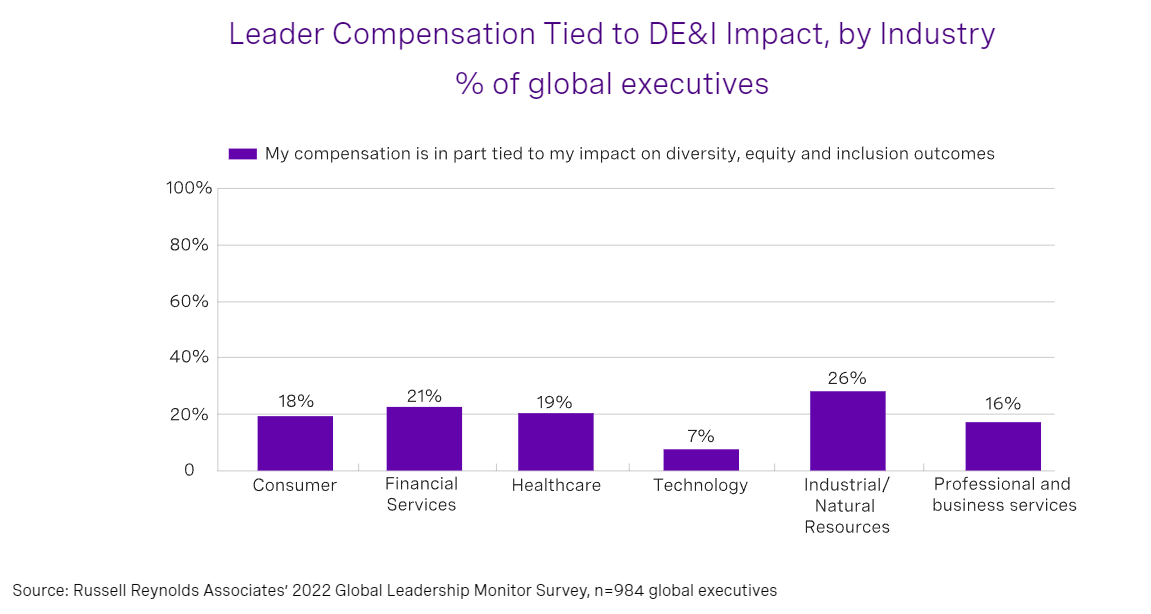Tina Shah Paikeday is the Global Head of the Diversity, Equity & Inclusion Practice at Russell Reynolds Associates. This post is based on an RRA memorandum by Ms. Paikeday, Nisa Qosja, and Jemi Crookes. Related research from the Program on Corporate Governance includes Politics and Gender in the Executive Suite (discussed on the Forum here) by Alma Cohen, Moshe Hazan, and David Weiss; Will Nasdaq’s Diversity Rules Harm Investors? (discussed on the Forum here) by Jesse M. Fried; and Duty and Diversity (discussed on the Forum here) by Chris Brummer and Leo E. Strine, Jr.
Although efforts to improve diversity, inclusion, and equity (DE&I) of employees and leaders in organizations continue, the number of organizations tangibly tracking accountability for the outcome of those efforts is still relatively low.
Russell Reynolds Associates’ 2022 Global Leadership Monitor research identified that just 17% of global leaders we surveyed said executives at their organizations are compensated on DE&I outcomes. Even against a benchmark that low, there is no single industry or region leading the way on DE&I accountability. The Technology industry lags notably behind.
Without accountability metrics, it’s virtually impossible for organizations to measure their leaderships’ performance against DE&I objectives and to compensate them accordingly, as they would with other measures of business performance. As many research studies show the link between DE&I and organizational performance, DE&I metrics should be included more widely as a component of compensation-based accountability models.
DE&I compensation-based accountability hinges on succession strategy, among other best practices.
RRA’s analysis of 984 global organizations across industries established a significant linear relationship between organizations that compensate leaders for DE&I outcomes and one essential practices that enables this type of accountability: having a strategic plan for increasing the diversity of the leadership succession candidate pool.
Strategic succession plans allow leaders to be thoughtful, tactful and deliberate about developing their pipeline to enable diverse representation.
This practice informs just part of the foundational building blocks for a sustainable DE&I operation. It’s equally important that each organization understands which additional DE&I outcomes are important to their context, employees, and communities to ensure that their accountability efforts reinforce what success means for them.
In our research of DE&I operating models at 158 organizations, we established that organizations that hit the ground running on DE&I with impressive momentum had a defined focus for their DE&I strategy and set accountability for that strategy by linking it to business results. We defined these organizations as on the “fast-track” to DE&I success.
Why does accountability matter? Because in recent years, leaders have implemented DE&I initiatives with mixed results according to Culture Amp’s 2022 Workplace DEI Report, which details that many diverse groups remain pessimistic about their inclusion in the workplace. Along with internal scrutiny of diversity initiatives, external stakeholders such as federal and state legislators have become increasingly vocal in their support of requiring government mandates for DE&I.
To hold their leaders accountable for DE&I outcomes and prepare for tougher rules and regulations around this best practice, organizations must include accountability measures in their DE&I operating model to signal to leaders that the DE&I imperative is as urgent of a priority as any other key business success measure.
 Print
Print
